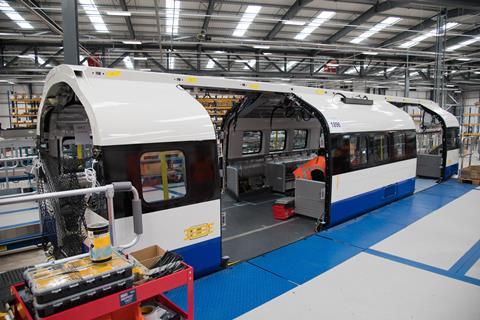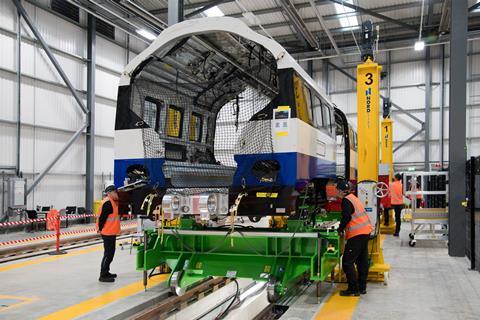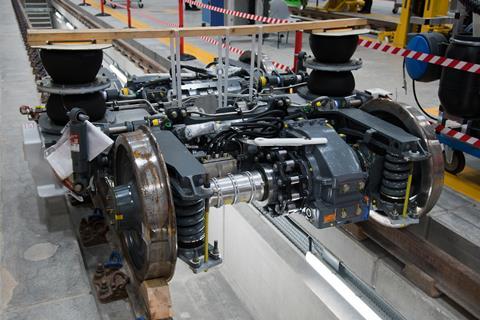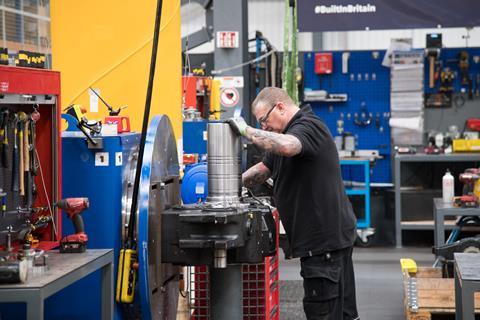
UK: The production of trains for the London Underground’s Piccadilly Line is ramping up at Siemens Mobility’s new factory in Goole.
An increase in the proportion of work being undertaken in the UK means that 79 of the 94 nine-car sets will now be manufactured at the Goole Rail Village, with the remainder being produced at Siemens Mobility plant at Wien in Austria.
Painted bodyshells are delivered to Goole from the Wien factory with windows and floors bonded in place, cable and equipment trays fitted at roof and underfloor levels and internal insulation material attached.

At Goole the assembly is completed at a series of locations designated MOAB stations, before vehicles are taken to the Trucking Building for measuring and load testing to ensure they are level before attachment to the bogies. Siemens Mobility allows a tolerance of no more than 1 mm between opposite corners of each vehicle.
Completed cars are moved around the site by electric vehicles which are guided by painted lines to ensure they present themselves in perfect alignment at each building.
The articulated design of the Inspiro London units means that each set runs on just 10 bogies, with the shorter IM (Intermediate) vehicles suspended between DM (Driving Motor) vehicles at each end or KM (Key Motor Car) vehicles through the rest of the formation.
Siemens Mobility notes that the design, which includes external doors and an equipment layout that enables improved headroom within vehicles, will increase capacity by 10% at current timetable frequencies and provide a smoother, quieter ride for passengers. The trains will consume 20% less energy than the existing fleet. The air-conditioning will be a first for deep-level tube trains, and real-time information systems will also improve the journey experience.
Bogies and commissioning

The bogies are manufactured at Siemens’ Graz facility and are delivered complete with motors, gearboxes, axles and wheels. The bespoke design features a notably short wheelbase to accommodate the London Underground’s tight curves. The challenges set for designers also resulted in the development of a combined motor housing and gearbox in a single casting. The axles can be slid out horizontally from the gearbox without needing to dismantle it to simplify maintenance work. The motors themselves represent the first use of permanent electromagnet motors by Siemens Mobility. Attachment to the DM and KM vehicles is via a central locating pin and a number of primary and secondary dampers.

In the final area, electrical testing is completed before assembly into a final nine-car set in the Train Formation Road. This process involves lifting the bogieless IM cars high enough to allow DM or KM cars to be moved into place on the tracks, then the suspended IMs are lowered into place and the articulation joints and anti-roll bars connected.
Initially it will only be possible to power up the sets at Goole, with trains taken to either Wildenrath in Germany or the RIDC test track near Melton Mowbray in the UK for dynamic testing. However, a 1 km test track is to be constructed next year to allow short commissioning runs to be carried out on site.
On the day of the formal opening on October 3, one KM and 11 shorter IM car bodies were on site in various stages of construction, including the first vehicle to be completed in the UK, IM car 92 for Train 15, which formed the backdrop for the ceremony.
The delivery of bodies for the first DM cars is expected to begin during October, enabling the first complete UK set to be rolled out in early 2025. Production will ramp up through the year to a rate of approximately 27 cars or three completed nine-car trains each month. This will involve the facility moving to two shifts and is expected to be achieved towards the end of 2025.
Other facilities

Elsewhere on the site, the Component Services facility employs around 80 people and has been expanded during its relocation from Leeds. This is now completing approximately 300 overhaul and repair tasks each month, both for Siemens Mobility and under contract to other manufacturers.
The Logistics Centre is now the warehousing facility for all of Siemens Mobility’s depots in the north of England.
The future Bogie Assembly & Service Centre to be operational in late 2026 will allow Siemens Mobility to assemble bogies in the UK for the first time, as well as overhauling those already in use. It is expected to create 200 additional jobs as well as securing 100 already in existence.



